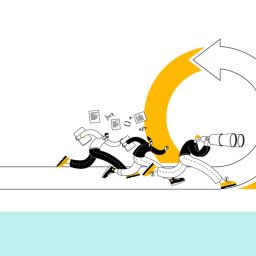
UX research is a continually evolving practice. So when we hear about something new, our ears prick up. Is this supposed new practice something we’ve been doing for years or something we should actually turn our attention to? Do such new methodologies explore alternative options to traditional UX research in a way that delivers a deeper understanding of our research findings in record time?
We work in a system that benefits from iterative practices of testing, testing, and re-testing. So how, when a few new buzzwords hit our radar—the latest of which we’re exploring in our current articles: continuous, rolling, and rapid research—can we be sure that they are new methodologies and not just a repackaged version of what we’re already doing with a trendier moniker, one designed to catch the collective market’s eye?
Well, we’re here to tell you that although you may recognise a lot of the tools and practices, they absolutely have something new to offer by reconsidering the use of organisation efficiency, scheduling, and pace. Designing such studies around pre-designed templates, guides, and strict schedules, they’re delivering fast and focused studies that provide valuable insights quicker and in easy-to-manage bite-sized results.
We can try to link these new methods to agile processes, but they’ve taken on a life of their own, pushing fast and frequent UX research to new heights.
Differentiating between each research process by definition
Hopefully, these short explanations/definitions will help to outline the key differences between each of these fast-moving user research programs:
Rapid Research:
A rapid research program is a standalone, lightweight process that explores and delivers quick feedback on a preset research topic chosen by the designers, researchers, or stakeholders.
Rolling Research:
Rolling research is an adaptive, lightweight research process that runs on a regular schedule. Its research topics develop depending on the findings, resulting data, and analysis of previous sessions.
Continuous research:
Continuous research is a rolling research process with no fixed research topic. This continuous research practice monitors existing data from its latest analytics and regular, scheduled user feedback to determine and navigate changes in operation, new trends, and other relevant information.
So, where’s the problem? Well, for example, rapid research, although considered a standalone single process, despite being primarily an evaluative operation, can reveal issues in the way generative research might, triggering further follow-up studies, and at that point, it starts to look very much like a rolling research study.
A rolling research session might reveal issues that can only be explored by digging into the latest analytics data, triggering a further follow-up that looks a lot like continuous research.
In addition to those example issues, several key components are common throughout each of the different methods, adding a little more confusion to the mix.
What do rapid research, rolling research, and continuous research have in common?
It can be easy to confuse one with another, as the terms rolling and continuous pretty much mean the same thing. Then, there’s the fact that rapid research suggests the same swift application of all these research sessions. What makes differentiating between them even more confusing is that they have several overlapping features.
- Fast turnarounds of a single or two-week sprint
- Lightweight processes
- Built on strict schedules, efficient templates, and rapid cycle evaluations
- Designed to save time and protect resources
- Simplified decision-making and stripped-down, single-page, easy-to-digest reporting
- Multiple teams can run multiple tests in the same session
- They appear to follow lean UX principles and look like existing design sprints
- Real-time, rapid feedback evaluations
- User interviews are executed in one session
- Enables fast product development
- Encourages participation of the whole company
With so many common elements, it’s easy to see how confusion can arise for those outside the field.
Let’s examine a few more things that distinguish each of these research operations.
Rapid Research
Core concepts
Rapid research allows for faster, more frequent studies into the areas stakeholders deem most important. It’s great for uncovering and analysing data on the fly, and with a regular schedule, it can attack questions from anyone in the whole company. So, from designers, product managers, the research team, or any stakeholders, anyone can suggest areas of exploration for their rapid research program.
Usage and applications
With its standardised documentation through templating scripts, practices, instruction, and reporting backed by an incredibly efficient and tight-packed schedule, rapid research is precisely that. Its speed to deliver insights is highly effective. With a weekly (or bi-weekly) cadence, it delivers new insights to boost design work, adding value to projects and products across the board.
Strengths and weaknesses
Like the other two processes under examination, they utilise fewer participants over significantly less time than traditional studies, making them unsuitable for certain studies (such as long-form quantitative interviews and diary studies). However, they’re great for exploring those simpler, more straightforward questions that may often be skipped for bigger, more extensive projects with a perceived higher value. There’s much to be said for a rapid research framework clearing the backlog of seemingly smaller unanswered questions and queries.
Rolling Research
Core concepts
Rolling research, like rapid research, allows for faster, more frequent studies but is far more adaptable. Each research project uncovers possible areas for further programs that can also dictate new research requests. It may be ideal as evaluative UX research, but given what each rolling research program reveals, it’s also very much a continuous discovery process.
Usage and applications
Again, rolling research is built on strict schedules, efficient organisation, time-saving templates, and automated processes wherever possible. It’s continuous and iterative, yet has the freedom of not following a strict plan. This results in a process that can navigate the latest trends, issues, practices, and more as they happen. With their findings and reports as simplified as their schedules, it’s simpler for the product team to apply them, updating operations more regularly.
Strengths and weaknesses
Rolling research deals with current trends and issues, is lightweight, streamlined, and easy to deliver, yet above all, its real strength is its adaptability.
On the flip side, such a fast and full-on pace demands a lot from its researchers and participants. Maintaining a high level of enthusiasm within a process that never lets up takes a special kind of researcher or practitioner. However, you can navigate burnout and fatigue by including rest periods in the process cadency or alternating teams between rolling research studies and traditional longer-form UX projects.
Finally, recruitment can be tricky with regular weekly studies, and with smaller subject pools and lighter documentation, a rolling research process might miss out on some of the information traditional UX research methodologies cover during their deep dives.
Continuous Research
Core concepts
As we said earlier, the core concept behind continuous research is that it has no fixed or specific subject of study, only to evaluate a product’s ongoing operation and its users’ needs and reactions to the latest trends or updates. The key advantage of continuous research is its fast reaction and response to user issues. It allows the research team to deliver an ongoing, in-depth understanding of their product, users, and behaviours.
However, it’s often difficult to convince shareholders of the value of continuous research without a specific issue to explore or a new feature to evaluate.
Usage and applications
Continuous research is an always-on, 24/7 research process that monitors at every point of the product lifecycle. Out of the three methodologies in today’s discussion, its application is the most generative. It picks out the poor-performing areas from existing data and analytics, with regular research into customer interactions through heatmaps, user interviews, site analytics and analysis.
Strengths and weaknesses
Its strength is in its organisation and ability to uncover issues we might never think to investigate. The strict schedule, just as with the other two practices we’re exploring, ensures that everyone knows exactly what stage the process is at, what they have to accomplish, and when. The findings are presented in a simple way everyone can understand without lengthy presentations or reports, and the data is shared in an accessible manner for all.
Conclusion
With their numerous similarities, it is easy to confuse the terms rapid, rolling, and continuous regarding these three UX research practices. We hope our latest pages, and indeed, this comparison, help shine a light on precisely what each does and why they’re such a great addition to UX research.
Our user research experts are available to help you get closer to your customers. If you would like to arrange a no obligation call, get in touch by emailing us at hello@ux247.com or share your requirement using the form below.





